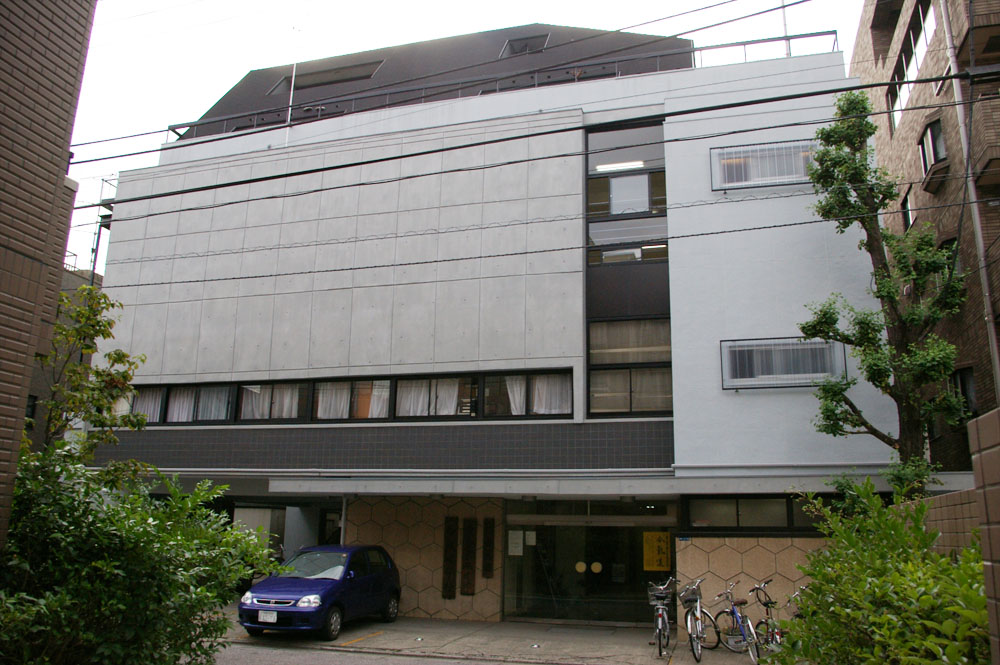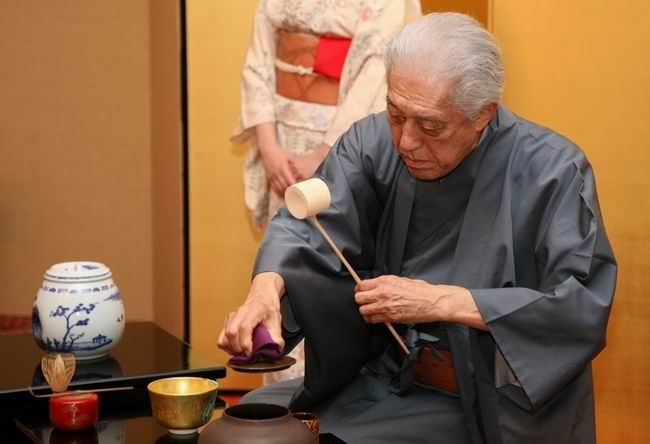|
Mitsuteru Ueshiba
is the son of the current Aikido Dōshu, Moriteru Ueshiba. In keeping with the iemoto system, he is expected to succeed his father as Dōshu. He is the great-grandson of Morihei Ueshiba, the Aikido founder. From April 2012, Ueshiba is Dojocho of the Aikikai Hombu Dojo, and as such is referred to as Waka-sensei ( 若 先生, "young master"). This term was applied to Moriteru Ueshiba when the second Dōshu Kisshomaru Ueshiba was still alive, and to Kisshomaru when the founder was still alive. More than simply a title of respect, it is intended to refer to the successor, who will take on leadership after his father. Personal life On March 2, 2008, Mitsuteru Ueshiba married Keiko Kusano. References External linksPhoto of father and son |
Moriteru Ueshiba
is a Japanese master of aikido. He is a grandson of Morihei Ueshiba, founder of aikido, and son of Kisshomaru Ueshiba. Ueshiba is the third and current ''Doshu'' (hereditary head) of the Aikikai. Biography Ueshiba was born on April 2, 1951, in Tokyo, Japan.Pranin, S. A. (''c.'' 2009)The Encyclopedia of Aikido: Ueshiba, Moriteru Retrieved on February 28, 2010. Retrieved on February 28, 2010. Recalling his childhood during a 2004 interview, he said, "The first time I wore an Aikido uniform I was in the first grade of elementary school. But my family didn’t force me to do ''keiko'' (training) then, I just did it when I felt like it. I started training seriously in my high school years. My intention then was to become a successor to my father, and to preserve Kaiso’s [...More Info...] [...Related Items...] OR: [Wikipedia] [Google] [Baidu] |
Kisshomaru Ueshiba
was a prominent Japanese master of aikido.Pranin, S. A. (''c.'' 2009)Encyclopedia of Aikido: Ueshiba, Kisshomaru Retrieved on March 1, 2010. He was the son of Morihei Ueshiba, founder of aikido, and became the international leader of aikido after his father's death.Goldsbury, P. (1999)Obituary: Doshu Kisshomaru UeshibaRetrieved on March 2, 2010. Early life Ueshiba was born on June 27, 1921, in the city of Ayabe, Kyoto Prefecture, Japan.Aikikai Foundation: Doshu chronology Retrieved on February 28, 2010. He was the third son and fourth child of Morihei Ueshiba and Hatsu Ueshiba (née Itokawa).Dang, P. T., & Seiser, L. (2006): ''Advanced Aikido'' (p. 3). Tokyo: Tuttle. ()Pranin, S. A. (1993) [...More Info...] [...Related Items...] OR: [Wikipedia] [Google] [Baidu] |
Aikido
Aikido ( , , , ) is a modern Japanese martial art that is split into many different styles, including Iwama Ryu, Iwama Shin Shin Aiki Shuren Kai, Shodokan Aikido, Yoshinkan, Renshinkai, Aikikai and Ki Aikido. Aikido is now practiced in around 140 countries. It was originally developed by Morihei Ueshiba, as a synthesis of his martial studies, philosophy and religious beliefs. Ueshiba's goal was to create an art that practitioners could use to defend themselves while also protecting their attackers from injury. Aikido is often translated as "the way of unifying (with) life energy" or as "the way of harmonious spirit". According to the founder's philosophy, the primary goal in the practice of aikido is to overcome oneself instead of cultivating violence or aggressiveness. Morihei Ueshiba used the phrase to refer to this principle. Aikido's fundamental principles include: (entering), , (breathing control), (triangular principle) and (turning) movements that redirect the oppo ... [...More Info...] [...Related Items...] OR: [Wikipedia] [Google] [Baidu] |
Aikikai
The Aikikai is the original school of Aikido. It is centered on the Aikikai#Aikikai Foundation, Aikikai Foundation in Japan, and its figurehead is the Aikikai#Doshu, Doshu (the family heir of the founder of Aikido). It is represented globally through the Aikikai#International Aikido Federation, International Aikido Federation. Aikikai Foundation The is the original aikido organization. It has been an incorporated entity in Japan since 1940 under the name , then re-registered under the name "Aikikai" after the ban on Aikido practice was lifted by the GHQ in 1948. It is headed by the doshu, the living successor of the founder of aikido. In its name, ''Kai'' (会) simply means assembly or club. The Aikikai Foundation operates Aikikai#Hombu dojo, Hombu dojo, which is also named Aikido World Headquarters. It is sometimes called the Aikikai Hombu to distinguish it from the headquarters of later aikido organisations. It is located in Tokyo. The term "Hombu" may sometimes be Metonym, ... [...More Info...] [...Related Items...] OR: [Wikipedia] [Google] [Baidu] |
Iemoto
is a Japanese term used to refer to the founder or current Grand Master of a certain school of traditional Japanese art. It is used synonymously with the term when it refers to the family or house that the iemoto is head of and represents. The word is also used to describe a system of familial generations in traditional Japanese arts such as tea ceremony (including ), , Noh, calligraphy, traditional Japanese dance, traditional Japanese music, the Japanese art of incense appreciation (), and Japanese martial arts. and Go once used the system as well. The system is characterized by a hierarchical structure and the supreme authority of the , who has inherited the secret traditions of the school from the previous . Titles An may be addressed by the title or , or by the title or . In English, is often translated as "Grand Master". The 's main roles are to lead the school and protect its traditions, to be the final authority on matters concerning the school, to issue or a ... [...More Info...] [...Related Items...] OR: [Wikipedia] [Google] [Baidu] |
Morihei Ueshiba
was a Japanese martial artist and founder of the martial art of aikido. He is often referred to as "the founder" or , "Great Teacher/Old Teacher (old as opposed to ''waka (young) sensei'')". The son of a landowner from Tanabe, Ueshiba studied a number of martial arts in his youth, and served in the Japanese Army during the Russo-Japanese War. After being discharged in 1907, he moved to Hokkaidō as the head of a pioneer settlement; here he met and studied with Takeda Sōkaku, the founder of Daitō-ryū Aiki-jūjutsu. On leaving Hokkaido in 1919, Ueshiba joined the Ōmoto-kyō movement, a Shinto sect, in Ayabe, where he served as a martial arts instructor and opened his first dojo. He accompanied the head of the Ōmoto-kyō group, Onisaburo Deguchi, on an expedition to Mongolia in 1924, where they were captured by Chinese troops and returned to Japan. The following year, he had a profound spiritual experience, stating that, "a golden spirit sprang up from the ground, veil ... [...More Info...] [...Related Items...] OR: [Wikipedia] [Google] [Baidu] |
Dojocho
{{Short pages monitor ... [...More Info...] [...Related Items...] OR: [Wikipedia] [Google] [Baidu] |
Aikikai Hombu Dojo
The Aikikai is the original school of Aikido. It is centered on the Aikikai Foundation in Japan, and its figurehead is the Doshu (the family heir of the founder of Aikido). It is represented globally through the International Aikido Federation. Aikikai Foundation The is the original aikido organization. It has been an incorporated entity in Japan since 1940 under the name , then re-registered under the name "Aikikai" after the ban on Aikido practice was lifted by the GHQ in 1948. It is headed by the doshu, the living successor of the founder of aikido. In its name, ''Kai'' (会) simply means assembly or club. The Aikikai Foundation operates Hombu dojo, which is also named Aikido World Headquarters. It is sometimes called the Aikikai Hombu to distinguish it from the headquarters of later aikido organisations. It is located in Tokyo. The term "Hombu" may sometimes be used loosely to refer to the upper echelons of instructors at Hombu dojo, or to the Aikikai Foundation itself. ... [...More Info...] [...Related Items...] OR: [Wikipedia] [Google] [Baidu] |
先生
Sensei, Seonsaeng, Tiên sinh or Xiansheng, corresponding to Chinese characters , is an East Asian honorific term shared in Japanese, Korean, Vietnamese and Chinese; it is literally translated as "person born before another" or "one who comes before". In general usage, it is used, with proper form, after a person's name and means "teacher"; the word is also used as a title to refer to or address other professionals or people of authority, such as clergy, accountants, lawyers, physicians and politicians or to show respect to someone who has achieved a certain level of mastery in an art form or some other skill, e.g., accomplished novelists, musicians, artists and martial artists. Etymology The two characters that make up the term can be directly translated as "born before" and imply one who teaches based on wisdom from age and experience. The word prefaced by the adjective 大, pronounced "dai" (or "ō"), which means "great" or "large", is often translated " grand master". ... [...More Info...] [...Related Items...] OR: [Wikipedia] [Google] [Baidu] |
YouTube
YouTube is a global online video platform, online video sharing and social media, social media platform headquartered in San Bruno, California. It was launched on February 14, 2005, by Steve Chen, Chad Hurley, and Jawed Karim. It is owned by Google, and is the List of most visited websites, second most visited website, after Google Search. YouTube has more than 2.5 billion monthly users who collectively watch more than one billion hours of videos each day. , videos were being uploaded at a rate of more than 500 hours of content per minute. In October 2006, YouTube was bought by Google for $1.65 billion. Google's ownership of YouTube expanded the site's business model, expanding from generating revenue from advertisements alone, to offering paid content such as movies and exclusive content produced by YouTube. It also offers YouTube Premium, a paid subscription option for watching content without ads. YouTube also approved creators to participate in Google's Google AdSens ... [...More Info...] [...Related Items...] OR: [Wikipedia] [Google] [Baidu] |
Japanese Aikidoka
Japanese may refer to: * Something from or related to Japan, an island country in East Asia * Japanese language, spoken mainly in Japan * Japanese people, the ethnic group that identifies with Japan through ancestry or culture ** Japanese diaspora, Japanese emigrants and their descendants around the world * Japanese citizens, nationals of Japan under Japanese nationality law ** Foreign-born Japanese, naturalized citizens of Japan * Japanese writing system, consisting of kanji and kana * Japanese cuisine, the food and food culture of Japan See also * List of Japanese people * * Japonica (other) * Japonicum * Japonicus * Japanese studies Japanese studies (Japanese: ) or Japan studies (sometimes Japanology in Europe), is a sub-field of area studies or East Asian studies involved in social sciences and humanities research on Japan. It incorporates fields such as the study of Japanese ... {{disambiguation Language and nationality disambiguation pages ... [...More Info...] [...Related Items...] OR: [Wikipedia] [Google] [Baidu] |
Living People
Related categories * :Year of birth missing (living people) / :Year of birth unknown * :Date of birth missing (living people) / :Date of birth unknown * :Place of birth missing (living people) / :Place of birth unknown * :Year of death missing / :Year of death unknown * :Date of death missing / :Date of death unknown * :Place of death missing / :Place of death unknown * :Missing middle or first names See also * :Dead people * :Template:L, which generates this category or death years, and birth year and sort keys. : {{DEFAULTSORT:Living people 21st-century people People by status ... [...More Info...] [...Related Items...] OR: [Wikipedia] [Google] [Baidu] |




